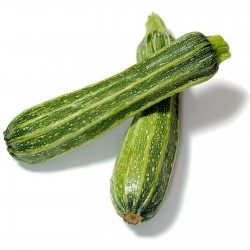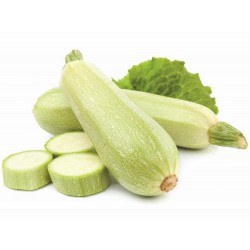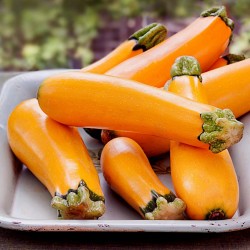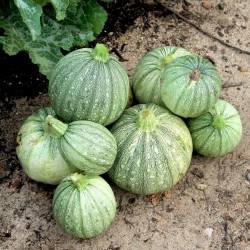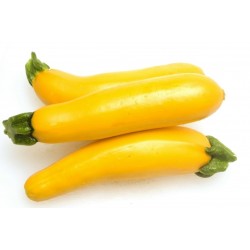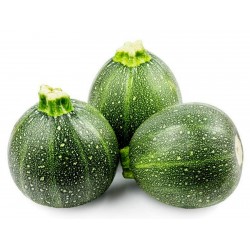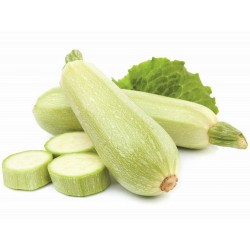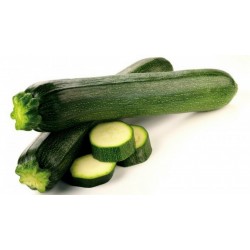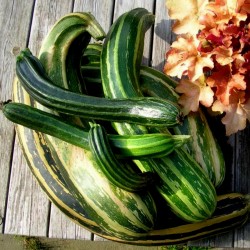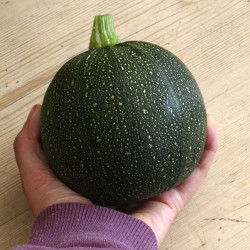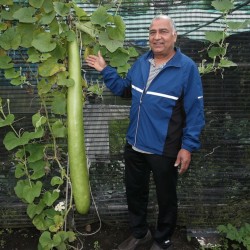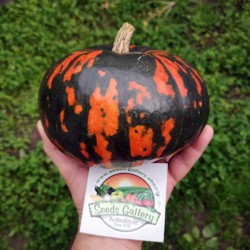
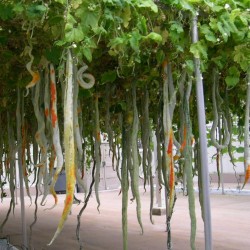
SNAKE GOURD Seeds...
Cena
2,35 €
(SKU: VG 11)
Seeds Gallery EU,
5/
5
<h2><strong>SNAKE GOURD Seeds (Trichosanthes cucumerina)</strong></h2>
<h2><span style="color:#ff0000;"><strong>Price for Package of 3 seeds.</strong></span></h2>
<p>Snake gourds are long and curved vegetables that fall into two different categories. There are the extremely long varieties that are grown for ornamental purposes and have hard skin and there are those grown for eating and medicinal purposes.</p>
<p>These Snake gourds have a waxy green skin and are often speckled or striped with a lighter shade of green. The fruit is eaten when young. Longer varieties are best harvested when they are between 16 and 18 inches long. Smaller varieties are best harvested at 6 to 8 inches in length.</p>
<p>When the gourd is young, the seeds are fairly nonexistent and the pulp around the seed mass is firm. The taste of a Snake gourd is similar to that of a cucumber. As a Snake gourd gets older, the rind gets hard and turns red. The taste becomes bitter and the insides gelatinous. The seeds are very hard and look similar to jagged-edged watermelon seeds. </p>
<p><strong>Seasons/Availability</strong><br />Snake gourds are available during the late summer and fall months. <strong></strong></p>
<p><strong>Current Facts</strong><br />Some of the longest gourds in the world are known as Snake gourd or ‘Serpent’ gourd. There are several varieties of Snake gourd that are cultivated and grown in India and other areas of the sub-tropics. These cucumber relatives can grow up to five or six feet long and when dried, can be made into a didgeridoo, an Australian Aboriginal wind instrument. Farmers tie stones to the ends of the fruit to weigh it down while it grows, to ensure straighter gourds. <strong></strong></p>
<p><strong>Applications</strong><br />Snake gourd can be prepared and used like zucchini; sautéed and served as a side dish or added to dishes with other sautéed vegetables. Snake gourds can also be stuffed or sliced and grilled. In Asian dishes, Snake gourd is made into chutneys and pickled. When the gourd is mature, the seed mass within is scraped out and used like tomato paste in various Indian dishes. <strong></strong></p>
<p><strong>Ethnic/Cultural Info</strong></p>
<p>In Ayurveda, the ancient medical system of India, the Snake gourd serves multiple purposes. Ingesting the fruit, leaves and flowers of the Snake gourd plant aided in digestive disorders, diabetes, skin diseases and general malaise. </p>
<p><strong>Geography/History</strong></p>
<p>Snake gourds are native to southeastern Asia, Australia and the islands of the Western Pacific. Originally domesticated in India, the serpent-like gourd can be found growing in Africa and other tropical and sub-tropical areas around the world. Botanically known as Trichosanthes cucumerina, Snake gourd seeds traveled from China to Europe via traders in the early 18th century, and were believed to have been planted at Monticello by Thomas Jefferson in 1820. </p>
<p> </p>
<h2>WIKIPEDIA:</h2>
<p>Trichosanthes cucumerina is a tropical or subtropical vine, its variety T. cucumerina var. anguina raised for its strikingly long fruit, in Asia eaten immature as a vegetable much like the summer squash, and in Africa, the reddish pulp of its mature fruit is used as an economical substitute of tomato.[2] Common names of the cultivated variety include snake gourd[note 1],[4] serpent gourd,[4] chichinda,[4] and padwal[4] (not to be confused with Trichosanthes dioica, the parwal, another gourd edible when immature).</p>
<p> </p>
<p>Trichosanthes cucumerina is found in the wild across much of South and Southeast Asia, including India, Bangladesh, Nepal, Pakistan, Sri Lanka, Indonesia, Malaysia, Myanmar (Burma), and southern China (Guangxi and Yunnan).[5] It is also regarded as native in northern Australia.[6][7] and naturalized in Florida,[8] parts of Africa and on various islands in the Indian and Pacific Oceans.[9]</p>
<p> </p>
<p>Formerly, the cultivated form was considered a distinct species, T. anguina, but it is now generally regarded as conspecific with the wild populations, as they freely interbreed:</p>
<p>Trichosanthes cucumerina var. anguina (L.) Haines – cultivated variant</p>
<p>Trichosanthes cucumerina var. cucumerina – wild variant</p>
<p> </p>
<p>Trichosanthes cucumerina is a monoecious annual vine climbing by means of tendrils. Leaves are palmately lobed, up to 25 cm long. Flowers are unisexual, white, opening at night, with long branching hairs on the margins of the petals. These hairs are curled up in the daytime when the flower is closed, but unfurl at night to form a delicate lacy display (see photos in gallery below). Fruits can be up to 200 cm long, deep red at maturity, hanging below the vine.</p>
<p>The related Japanese snake gourd (Trichosanthes pilosa, sometimes called T. ovigera or T. cucumeroides), very similar in vegetative morphology, but the fruit of T. pilosa is round to egg-shaped, only about 7 cm long.</p>
<p> </p>
<p><strong>Uses</strong></p>
<p>The common name "snake gourd" refers to the narrow, twisted, elongated fruit. The soft-skinned immature fruit can reach up to 150 cm (59 in) in length. Its soft, bland, somewhat mucilaginous flesh is similar to that of the luffa and the calabash. It is popular in the cuisines of South Asia and Southeast Asia and is now grown in some home gardens in Africa. With some cultivars, the immature fruit has an unpleasant odor and a slightly bitter taste, both of which disappear in cooking. The fruit becomes too bitter to eat as it reaches maturity, but it does contain a reddish pulp that is used in Africa as a substitute for tomatoes.</p>
<p>The shoots, tendrils, and leaves are also eaten as greens.</p>
<p> </p>
<p> </p>
VG 11 (3 S)













